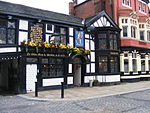St Patrick's Church, Bolton
1861 establishments in England19th-century Roman Catholic church buildings in the United KingdomBuildings and structures in BoltonGothic Revival architecture in Greater ManchesterGothic Revival church buildings in England ... and 5 more
Grade II listed Roman Catholic churches in EnglandGrade II listed churches in the Metropolitan Borough of BoltonRoman Catholic Diocese of SalfordRoman Catholic churches completed in 1861Roman Catholic churches in Greater Manchester

St Patrick's Church is a Roman Catholic Church in Bolton, Greater Manchester, England. It was built in 1861 and is a Gothic Revival style building. It is situated on the corner of Great Moor Street and Johnson Street, to the west of Bradshawgate in the centre of the town. It is a Grade II listed building.
Excerpt from the Wikipedia article St Patrick's Church, Bolton (License: CC BY-SA 3.0, Authors, Images).St Patrick's Church, Bolton
Johnson Street,
Geographical coordinates (GPS) Address External links Nearby Places Show on map
Geographical coordinates (GPS)
| Latitude | Longitude |
|---|---|
| N 53.5765 ° | E -2.4273 ° |
Address
St. Patrick's Catholic Church
Johnson Street
BL1 1NS , The Haulgh
England, United Kingdom
Open on Google Maps







